Sustainable People Home-Work Logistics: An Integrated Model of Circular Economy in the Chiampo Valley
Abstract
:1. Introduction
2. Traffic Demand Management Background
3. IBTDM Methodological Framework for Sustainable People Home-Work Logistics
- Scalability: the IBTDM methodological framework can be extended thanks to the possibility to add new territories to the project and consequently new actors.
- Self-sustainability: the IBTDM methodological framework is based on incentives funded by the same actors of the project, i.e., public administrations and companies; moreover, the time and the fund values do not influence the adapted methodology. The operative issues are guaranteed by a third party, external to the actors but controlled by them, that manages, controls, and supports all the processes, even through the Internet of things (IoT).
- Territorial circular economy: the IBTDM methodological framework is based on incentives funded by territorial actors (local administrations and companies), that can be used only in territorial shops.
- Public-private integration: the IBTDM methodological framework is based on strong integration between public (local administrations) and private (companies, shops, workers) actors, supporting a territorial and social company model, which actively participates in the well-being of citizens and the good administration of the territory.
- Local Administrations: improvement of traffic flow in the area, especially during peak hours; model of incentives for their citizens.
- Local Companies: better traffic fluidity on the roads for the circulation of their goods and less area needed for company car parks; model of incentives for their employees.
- Local Workers: Reduction of queue times and potentially of time for moving from home to work, with preserving one’s independence in mobility (i.e., bicycle); Possible increase of monthly income.
- Local Shops: Improvement of traffic flows in the area, especially in the city centre where the shops are located; a possible increase of monthly income.
4. Case Study
- Average daily home-work trip for each worker: 3.82 Km (3.82 Km home-work and 3.82 work-home), with a minimum value of 1.02 Km and a maximum value of 8.71 Km.
- Average daily economic benefit for workers: 1.8 €/day (about 40 €/month)
- Average daily CO2 saved for workers: 1016 Kg (about 22.36 Kg/month)
5. Conclusions
Author Contributions
Funding
Institutional Review Board Statement
Informed Consent Statement
Data Availability Statement
Acknowledgments
Conflicts of Interest
References
- Witchayaphong, P.; Pravinvongvuth, S.; Kanitpong, K.; Sano, K.; Horpibulsuk, S. Influential factors affecting travelers’ mode choice behavior on mass transit in Bangkok, Thailand. Sustainability 2020, 12, 522. [Google Scholar] [CrossRef]
- Wei, Y.; Huang, C.; Lam, P.T.I.; Sha, Y.; Feng, Y. Using urban-carrying capacity as a benchmark for sustainable urban development: An empirical study of Beijing. Sustainability 2015, 7, 3244–3268. [Google Scholar] [CrossRef] [Green Version]
- Kumar, V.; Bhat, C.R.; Pendyala, R.M.; You, D.; Ben-Elia, E.; Ettema, D. Impacts of incentive-based intervention on peak period traffic: Experience from the Netherlands. Transp. Res. Rec. 2016, 2543, 166–175. [Google Scholar] [CrossRef] [Green Version]
- Sun, J.; Wu, J.; Xiao, F.; Tian, Y.; Xu, X. Managing bottleneck congestion with incentives. Transp. Res. Part B Methodol. 2020, 134, 143–166. [Google Scholar] [CrossRef]
- Litman, T. The Online TDM Encyclopedia: Mobility management information gateway. Transp. Policy 2003, 10, 245–249. [Google Scholar] [CrossRef]
- Higgins, T.J. Demand management in suburban settings. Transportation 1990, 17, 93–116. [Google Scholar] [CrossRef]
- Tian, Y.; Li, Y.; Sun, J.; Ye, J. Characterizing favored users of incentive-based traffic demand management program. Transp. Policy 2021, 105, 94–102. [Google Scholar] [CrossRef]
- Bauer, J.; Bedsole, L.K.; Snyder, K.; Neuner, M.; Smith, M.C. Expanding Traveler Choices through the Use of Incentives: A Compendium of Examples; US Department of Transportation: Washington, DC, USA, 2018. Available online: https://ops.fhwa.dot.gov/publications/fhwahop18071/index.htm#toc (accessed on 8 July 2021).
- Ben-Elia, E.; Ettema, D. Carrots versus sticks: Rewarding commuters for avoiding the rush-hour-a study of willingness to participate. Transp. Policy 2009, 16, 68–76. [Google Scholar] [CrossRef]
- Koppelman, F.S.; Bhat, C.R.; Schofer, J.L. Market research evaluation of actions to reduce suburban traffic congestion: Commuter travel behavior and response to demand reduction actions. Transp. Res. Part A 1993, 27, 383–393. [Google Scholar] [CrossRef]
- Tsirimpa, A.; Polydoropoulou, A.; Pagoni, I.; Tsouros, I. A reward-based instrument for promoting multimodality. Transp. Res. Part F Traffic Psychol. Behav. 2019, 65, 121–140. [Google Scholar] [CrossRef]
- Chang, G.L.; Mahmassani, H.S. Travel time prediction and departure time adjustment behavior dynamics in a congested traffic system. Transp. Res. Part B 1988, 22, 217–232. [Google Scholar] [CrossRef]
- Saleh, W.; Farrell, S. Implications of congestion charging for departure time choice: Work and non-work schedule flexibility. Transp. Res. Part A Policy Pract. 2005, 39, 773–791. [Google Scholar] [CrossRef]
- Hashemi, H.; Abdelghany, K. Real-time traffic network state prediction for proactive traffic management: Simulation experiments and sensitivity analysis. Transp. Res. Rec. 2015, 2491, 22–31. [Google Scholar] [CrossRef]
- Abdelghany, K.; Hashemi, H.; Khodayar, M.E. A decision support system for Proactive-Robust traffic network management. IEEE Trans. Intell. Transp. Syst. 2018, 20, 297–312. [Google Scholar] [CrossRef]
- Le, T.; Vu, H.L.; Walton, N.; Hoogendoorn, S.P.; Kovács, P.; Queija, R.N. Utility optimization framework for a distributed traffic control of urban road networks. Transp. Res. Part B Methodol. 2017, 105, 539–558. [Google Scholar] [CrossRef] [Green Version]
- Wang, J.; Chi, L.; Hu, X.; Zhou, H. Urban traffic congestion pricing model with the consideration of carbon emissions cost. Sustainability 2014, 6, 676–691. [Google Scholar] [CrossRef] [Green Version]
- Bonsall, P.; Shires, J.; Maule, J.; Matthews, B.; Beale, J. Responses to complex pricing signals: Theory, evidence and implications for road pricing. Transp. Res. Part A Policy Pract. 2007, 41, 672–683. [Google Scholar] [CrossRef]
- Schaller, B. New York City’s congestion pricing experience and implications for road pricing acceptance in the United States. Transp. Policy 2010, 17, 266–273. [Google Scholar] [CrossRef] [Green Version]
- Gneezy, U.; Rustichini, A. A fine is a price. J. Legal Stud. 2000, 29, 117. [Google Scholar] [CrossRef] [Green Version]
- Mahmassani, H.S.; Zhou, X.; Lu, C.C. Toll pricing and heterogeneous users: Approximation algorithms for finding bicriterion time-dependent efficient paths in large-scale traffic networks. Transp. Res. Rec. 2005, 1923, 28–36. [Google Scholar] [CrossRef]
- Small, K.A.; Yan, J. The value of ‘value pricing’ of roads: Second-best pricing and product differentiation. J. Urban Econ. 2001, 49, 310–336. [Google Scholar] [CrossRef] [Green Version]
- Lam, T.C.; Small, K.A. The value of time and reliability: Measurement from a value pricing experiment. Transp. Res. Part E Logist. Transp. Rev. 2001, 37, 231–251. [Google Scholar] [CrossRef] [Green Version]
- Phang, S.Y.; Toh, R.S. From manual to electronic road congestion pricing: The Singapore experience and experiment. Transp. Res. Part E Logist. Transp. Rev. 1997, 33, 97–106. [Google Scholar] [CrossRef]
- Lin, X.; Susilo, Y.O.; Shao, C.; Liu, C. The implication of road toll discount for mode choice: Intercity travel during the Chinese spring festival holiday. Sustainability 2018, 10, 2700. [Google Scholar] [CrossRef] [Green Version]
- Ramandanis, I.D.; Politis, I.; Basbas, S. Assessing the environmental and economic footprint of electronic toll collection lanes: A simulation study. Sustainability 2020, 12, 9578. [Google Scholar] [CrossRef]
- Li, X.; Lv, Y.; Sun, W.; Zhou, L. Cordon- or link-based pricing: Environment-oriented toll design models development and application. Sustainability 2019, 11, 258. [Google Scholar] [CrossRef] [Green Version]
- Brumercikova, E.; Bukova, B.; Nedeliakova, E. A proposal for the account-based ticketing application in passenger transport in the Slovak Republic: A case study. Sustainability 2020, 12, 5491. [Google Scholar] [CrossRef]
- Faccio, M.; Persona, A.; Sgarbossa, F.; Zanin, G. Multi-stage supply network design in case of reverse flows: A closed-loop approach. Int. J. Oper. Res. 2011, 12, 157–191. [Google Scholar] [CrossRef]
- Wu, J.; Tian, Y.; Sun, J. A bilevel programming framework for determining the optimal incentive-based traffic demand management strategy. In Proceedings of the 19th COTA International Conference of Transportation Professionals (CICTP 2019: Transportation in China—Connecting the World), Nanjing, China, 6–8 July 2019; pp. 5900–5912. [Google Scholar] [CrossRef]
- Arian, A.; Ermagun, A.; Zhu, X.; Chiu, Y.-C. An Empirical Investigation of the Reward Incentive and Trip Purposes on Departure Time Behavior Change. In Advances in Transport and Policy; Elsevier: Amsterdam, The Netherlands, 2018. [Google Scholar] [CrossRef]
- Merugu, D.; Prabhakar, B.S.; Rama, N. An Incentive Mechanism for Decongesting the Roads: A Pilot Program in Bangalore. In Proceedings of the NetEcon Workshop, Stanford, CA, USA, 7 July 2009. [Google Scholar]
- Ettema, D.; Knockaert, J.; Verhoef, E. Using incentives as traffic management tool: Empirical results of the ‘peak avoidance’ experiment. Transp. Lett. 2010, 2, 39–51. [Google Scholar] [CrossRef]
- Ben-Elia, E.; Ettema, D. Changing commuters’ behavior using rewards: A study of rush-hour avoidance. Transp. Res. Part F Traffic Psychol. Behav. 2011, 14, 354–368. [Google Scholar] [CrossRef]
- Bamberg, S.; Ajzen, I.; Schmidt, P. Choice of Travel Mode in the Theory of Planned Behavior: The Roles of Past Behavior, Habit, and Reasoned Action. Basic Appl. Soc. Psych. 2003, 25, 175–187. [Google Scholar] [CrossRef]
- Sun, Y.; Zhang, L. Microeconomic model for designing public transit incentive programs. Transp. Res. Rec. 2018, 2672, 77–89. [Google Scholar] [CrossRef]
- Zhang, P.; Qian, Z. Managing traffic with raffles. Transp. Res. Part C Emerg. Technol. 2019, 107, 490–509. [Google Scholar] [CrossRef]
- Andersson, A.; Hiselius, L.W.; Adell, E. Promoting sustainable travel behaviour through the use of smartphone applications: A review and development of a conceptual model. Travel Behav. Soc. 2018, 11, 52–61. [Google Scholar] [CrossRef] [Green Version]
- Ermagun, A.; Fan, Y.; Wolfson, J.; Adomavicius, G.; Das, K. Real-time trip purpose prediction using online location-based search and discovery services. Transp. Res. Part C Emerg. Technol. 2017, 77, 96–112. [Google Scholar] [CrossRef]
- Azevedo, C.L.; Seshadri, R.; Gao, S.; Atasoy, B.; Akkinepally, A.; Christofa, E.; Zhao, F.; Trancik, J.; Ben-Akiva, M. Tripod: Sustainable Travel Incentives with Prediction, Optimization, and Personalization. In Proceedings of the 97th Annual Meeting Transportation Research Board, Washington, DC, USA, 7–11 January 2018; Volume 1, p. 19. [Google Scholar]
- Hu, X.; Chiu, Y.C.; Zhu, L. Behavior Insights for an Incentive-Based Active Demand Management Platform. Int. J. Transp. Sci. Technol. 2015, 4, 119–133. [Google Scholar] [CrossRef] [Green Version]
- Hu, X.; Zhu, X.; Chiu, Y.C.; Tang, Q. Will information and incentive affect traveler’s day-to-day departure time decisions?—An empirical study of decision making evolution process. Int. J. Sustain. Transp. 2020, 14, 403–412. [Google Scholar] [CrossRef]
- Jariyasunant, J.; Abou-Zaied, M.; Carrel, A.; Venkatesan, E.; Gaker, D.; Sengupta, R.; Walker, J.L. Quantified traveler: Travel feedback meets the cloud to change behavior. J. Intell. Transp. Syst. Technol. Plan. Oper. 2015, 19, 109–124. [Google Scholar] [CrossRef]
- Li, T.; Chen, P.; Tian, Y. Personalized incentive-based peak avoidance and drivers’ travel time-savings. Transp. Policy 2021, 100, 68–80. [Google Scholar] [CrossRef]
- Diversamente in Movimento. Study Developed in Collaboration with the University of Padova. 2017. Available online: https://www.confartigianatovicenza.it/diversamente-in-movimento-uno-studio-per-una-migliore-viabilita-nella-valle-del-chiampo-voluto-da-confartigianato-e-comuni-di-arzignano-e-chiampo (accessed on 12 August 2021).
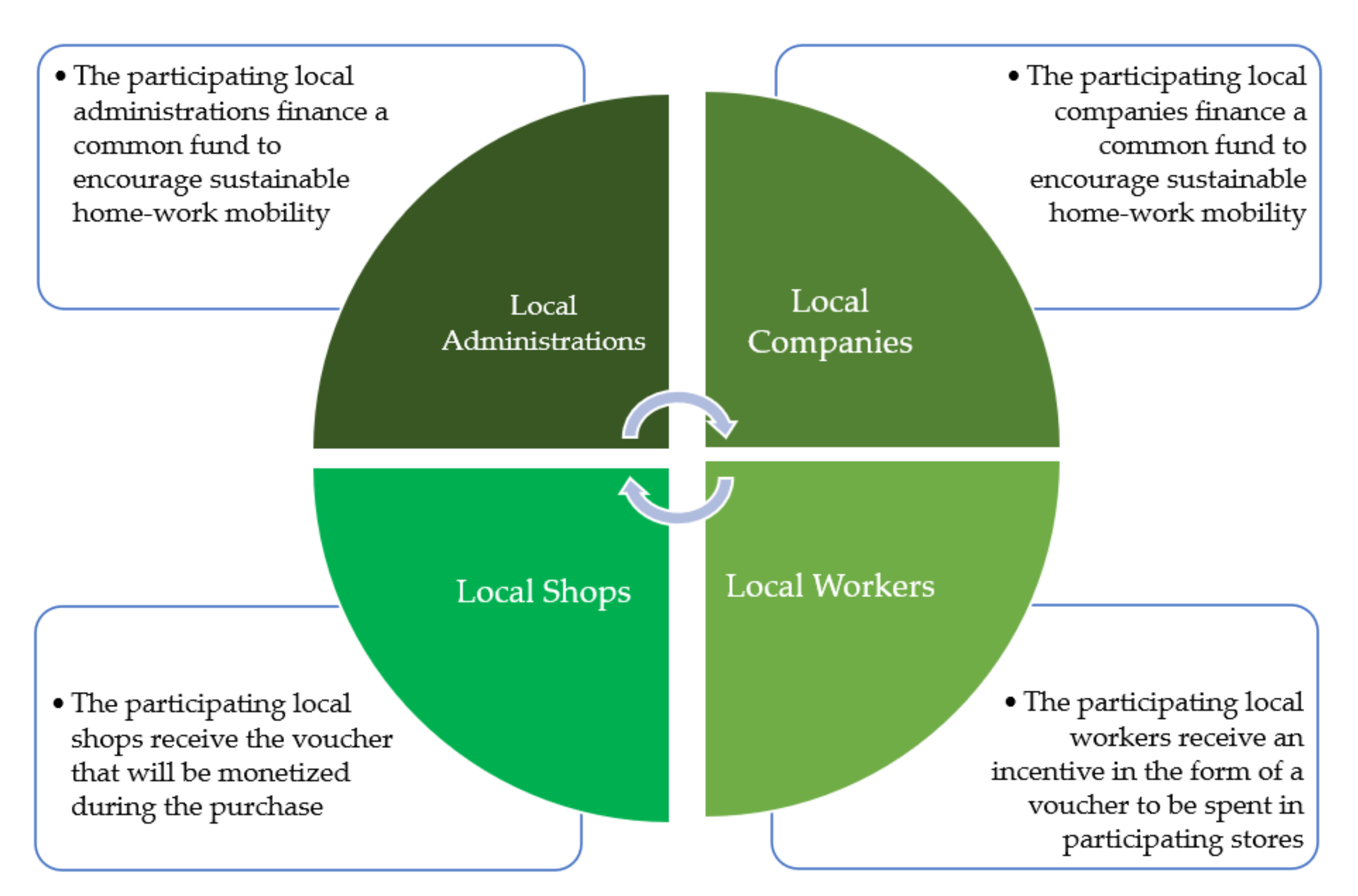
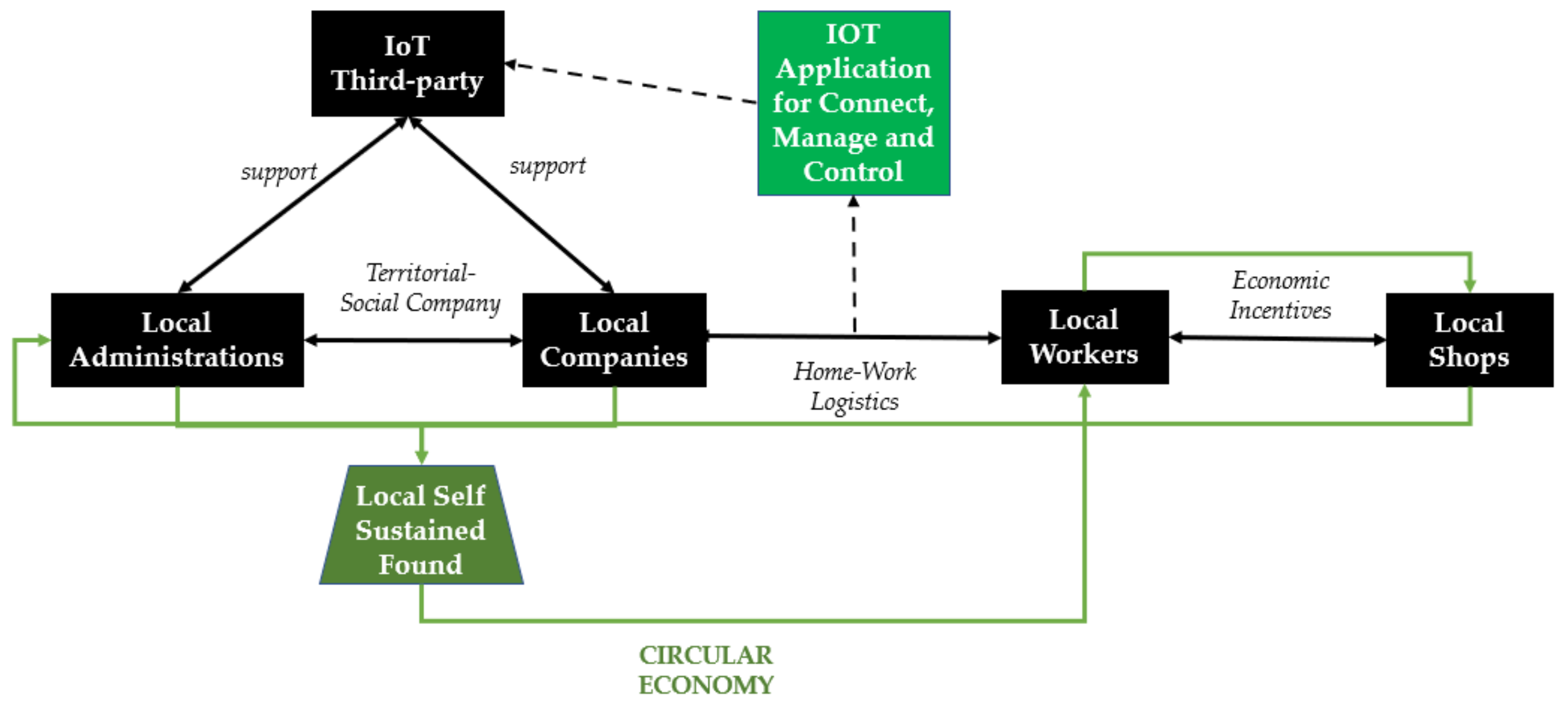
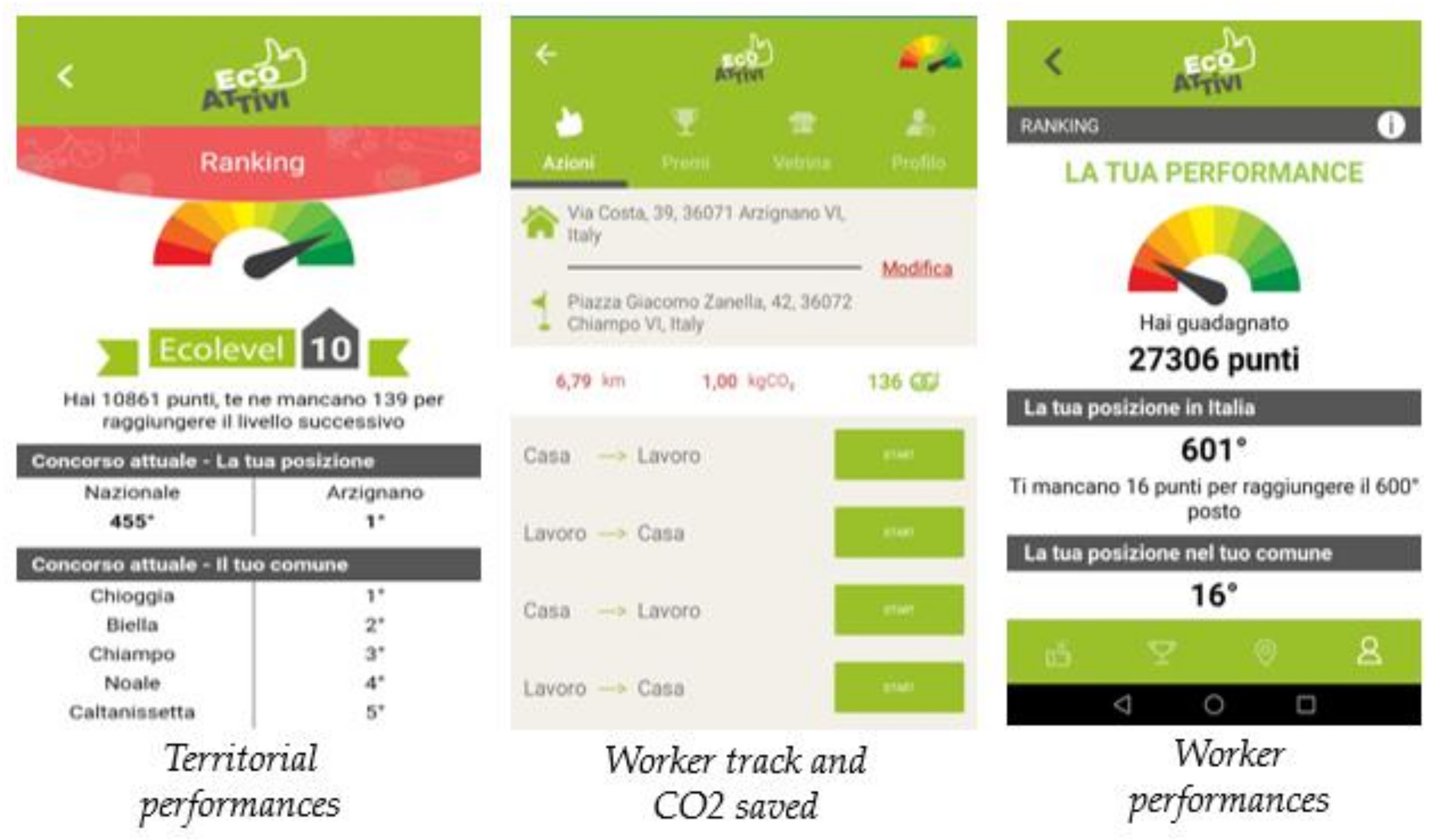

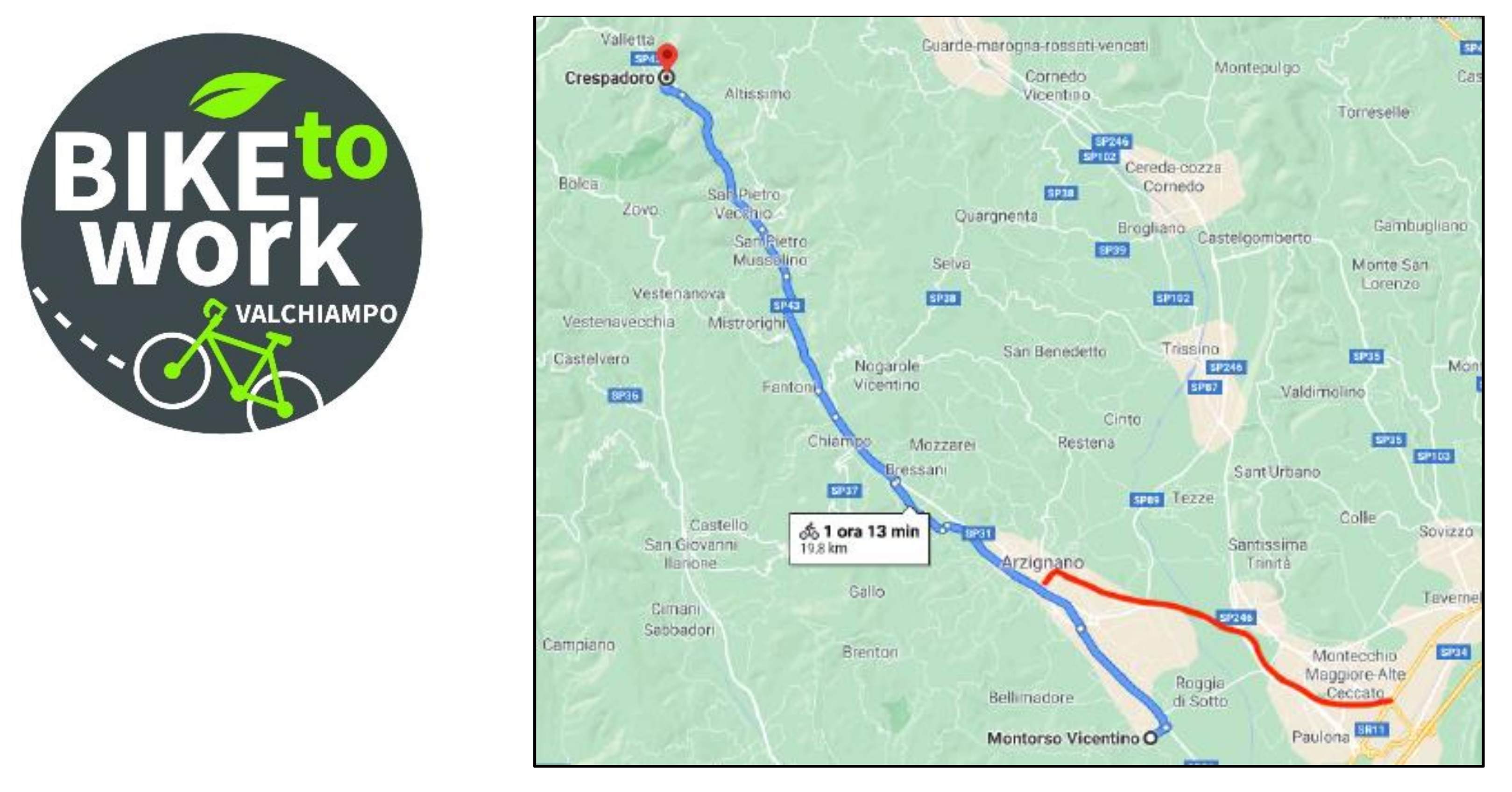
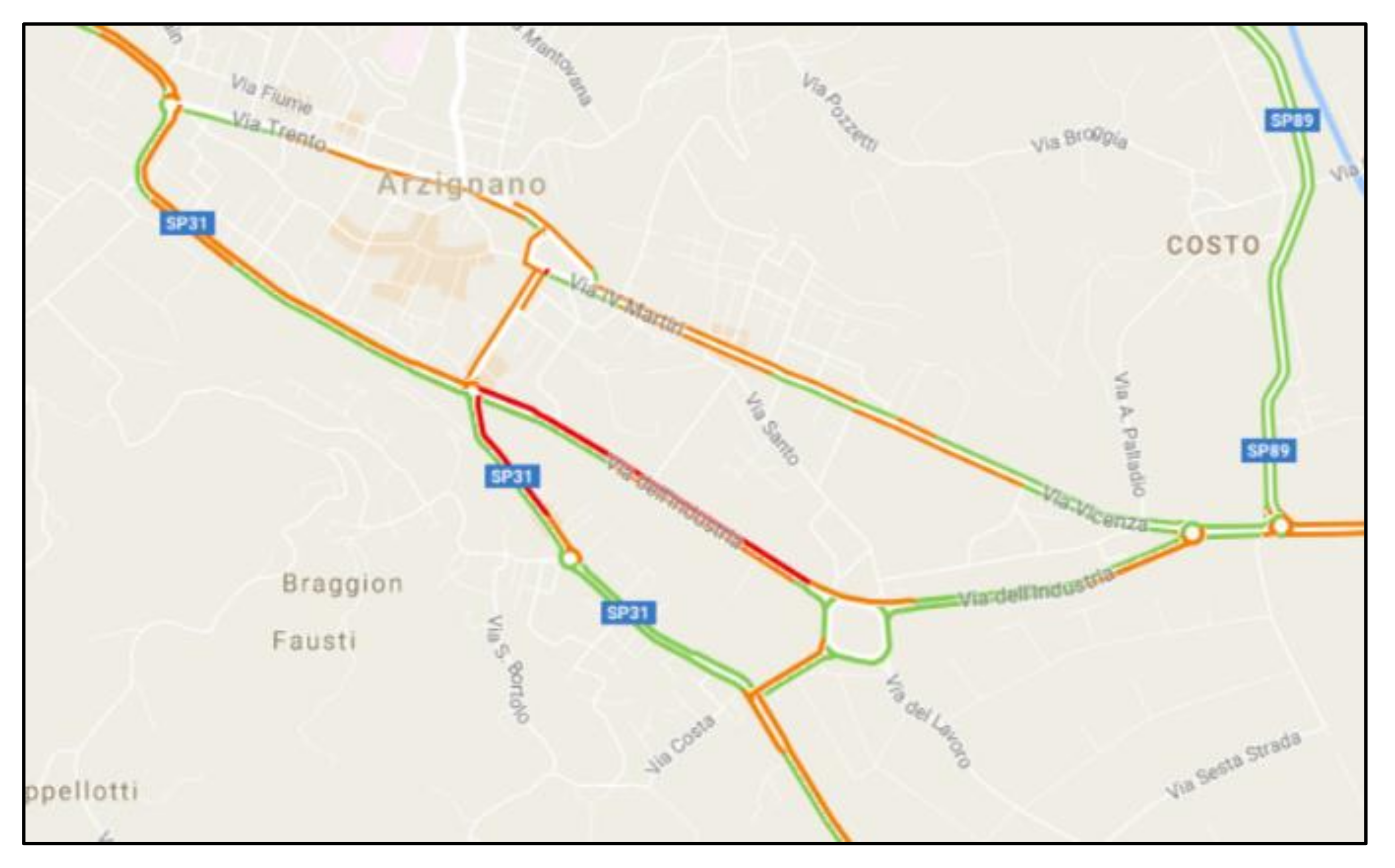

| Objectives | Novelty Elements | Actors | Mobility Systems |
|---|---|---|---|
| Promotion of sustainable mobility systems and well-being | Scalability | Local Administrations | Bicycle (traditional or electric) |
| Traffic decongestion and improvement of air quality | Self-sustainability (Economical and operational) | Local Companies | Scooter (traditional or electric) |
| Human-centred city versus car-centred city | Territorial circular economy | Local Workers | Foot |
| Incentive to the local economy and | Public-private integration | Local Shops | Potential extension to other sustainable mobility systems |
| Companies | Workers | Potential Sustainable Transportation System | ||||||
|---|---|---|---|---|---|---|---|---|
| Contacted | Responding | Interested | Contacted | Responding | Interested | Contacted | Responding | Interested |
| 154 | 40 | 17 | 680 | 204 | 185 | 112 | 72 | 1 |
| 100.0% | 26.0% | 42.5% | 100.0% | 30.0% | 90.7% | 60.5% | 38.9% | 0.5% |
Publisher’s Note: MDPI stays neutral with regard to jurisdictional claims in published maps and institutional affiliations. |
© 2021 by the authors. Licensee MDPI, Basel, Switzerland. This article is an open access article distributed under the terms and conditions of the Creative Commons Attribution (CC BY) license (https://creativecommons.org/licenses/by/4.0/).
Share and Cite
Faccio, M.; Finco, S.; Zennaro, I. Sustainable People Home-Work Logistics: An Integrated Model of Circular Economy in the Chiampo Valley. Sustainability 2021, 13, 12009. https://doi.org/10.3390/su132112009
Faccio M, Finco S, Zennaro I. Sustainable People Home-Work Logistics: An Integrated Model of Circular Economy in the Chiampo Valley. Sustainability. 2021; 13(21):12009. https://doi.org/10.3390/su132112009
Chicago/Turabian StyleFaccio, Maurizio, Serena Finco, and Ilenia Zennaro. 2021. "Sustainable People Home-Work Logistics: An Integrated Model of Circular Economy in the Chiampo Valley" Sustainability 13, no. 21: 12009. https://doi.org/10.3390/su132112009
APA StyleFaccio, M., Finco, S., & Zennaro, I. (2021). Sustainable People Home-Work Logistics: An Integrated Model of Circular Economy in the Chiampo Valley. Sustainability, 13(21), 12009. https://doi.org/10.3390/su132112009







